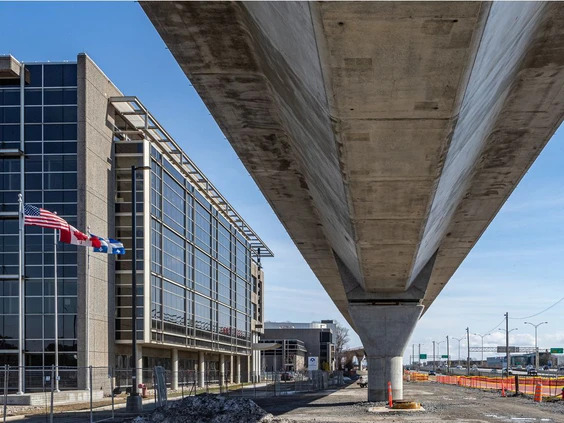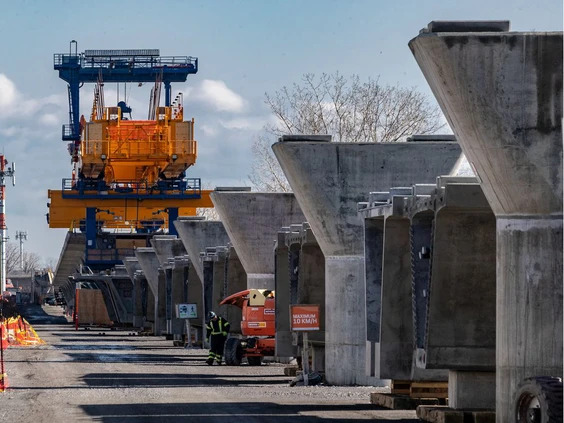Article relatant quelques commentaires des maires et de la mairesse des villes du West Island au sujet de la structure aérienne de l’antenne Anse-à-l’Orme. Cela servira possiblement de matière à réflexion pour le REM2… ![]()
Is massive REM structure an eyesore on West Island landscape?
If the proposed REM is viewed a blight on east-end Montreal, how does the elevated structure alter the West Island’s suburban landscape?
Montreal Gazette | John Meagher | Apr 09, 2021

Construction of the REM along Highway 40 in the West Island continues. PHOTO BY DAVE SIDAWAY /Montreal Gazette
If the prospect of an elevated REM line in the east-end of Montreal could be foreseen as an eyesore on the urban skyline, how will the sight of the West Island’s line affect the suburban landscape?
With large concrete columns being constructed along Highway 40 through the heart of the West Island, local mayors say the benefits of a modern transportation system linking the suburbs to downtown Montreal outweigh aesthetical concerns.
But Ste-Anne-de-Bellevue Mayor Paola Hawa is among those who doesn’t find the REM architecturally inspiring.
“It’s too bad it’s taken this long for people to actually flag that. I mean, come on, we’ve all seen it. It ain’t pretty.”
The REM’s 14.5 kilometre western line will end at Anse-à-l’Orme station in Ste-Anne. It is the only ground-level station in the West Island.
Hawa realizes the Caisse de dépôt et placement du Québec had little wiggle room in terms of finding space to build a 67-kilometre light rail network across the Greater Montreal area.
“Doing it at ground level would have meant a lot of land expropriation. The cost would have been even more prohibitive. I understand they didn’t have a million and one options,” she said. “If there had been a possibility of building it on the south side along Highway 20, that would have been perfect. But no matter which way you looked at it, turning it upside down or sideways, there was no way to get that done. Especially now with more distribution of goods by train. You can’t share train tracks.”
Kirkland Mayor Michel Gibson has no qualms about the REM’s structural look. He says it will blend into the modern setting of Kirkland.
“We’re a young city, 60 years old, so the buildings we have are not dilapidated . . . that type of structure fits with the surroundings,” he said. “The Kirkland station will look nice; the actual train on the rail will look nice.”
Gibson said he understands why an elevated structure might not be a good fit for parts of the east-end. “It’s about the surroundings. If you put that in the east-end or in the older sector of Montreal, it could look out of place like the Olympic Stadium.”
He said the REM is also driving up local real estate prices.
“The real estate in Kirkland is going out of this world. It’s unbelievable.”
Dollard-des-Ormeaux Mayor Alex Bottausci said the REM will also have a positive effect on local commercial property.
“The advent of the REM coming in pushed either the demand for our land and older properties on our territories to be revamped. The important thing is to have developer not necessarily develop what they feel like developing but what our community actually collectively needs, and try and find a good balance between the two.”
Although there is no REM station in Dollard, there are several in proximity to its borders, including Des Sources and Fairview-Pointe-Claire and Sunnybrooke in Pierrefonds-Roxboro.
Bottausci said there are trade-offs for having massive infrastructure built above ground in urban areas.
“My opinion is that it’s best if you can keep it on the ground. Anything that gets elevated starts to become an eyesore, but you do have existing infrastructure that you need to work around.
“And to the REM’s defence, and I have questioned them on this in the past . . . they say if you want us to deliver transportation times — in other words we want to run this train every five minutes — we can’t have crossroads or (ground-level) barriers. You can’t have that. You need to be able to travel without interruptions.
“If that’s what brings transportation to a whole new level, along with the expectations of the traveler, then that’s what we need to do as a community.”
The REM’s West Island line is slated to be operational by 2024.
After the novelty wears off, Hawa hopes West Islanders will still like the look of the massive concrete structure in 2035.
“It doesn’t hurt my eyes so much right now . . . but in 10 or 15 years and I can’t see how it will age well.
“As I’ve said before, it will be a graffiti magnet. How long before that happens? It won’t take long at all. Then what?”
Gibson shares those concerns about graffiti.
“In Kirkland, we don’t tolerate graffiti. If they don’t remove it, we’ll remove it ourselves and send (the REM) the bill,” he said. “For now though, the look itself doesn’t bother me.”

Construction of the REM infrastructure along Highway 40 in the West Island continues. PHOTO BY DAVE SIDAWAY /Montreal Gazette